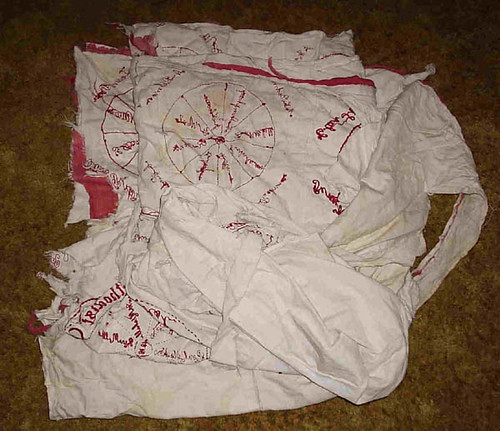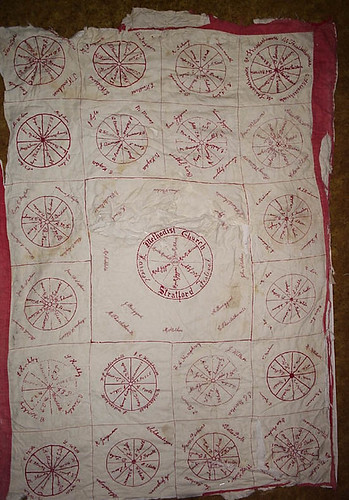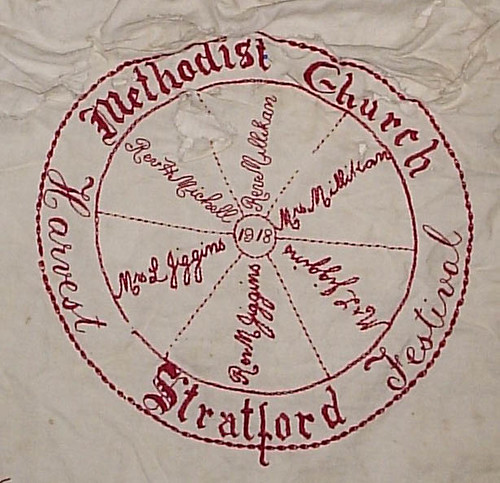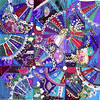Rescue Mission Ahead
A major rescue mission is about to be launched!
In my "spare" time I have been helping out at a local history museum, where the museum has been closed for over 12 months for redevelopment. We are currently sorting through everything, including things that have come in and have not yet been catalogued, but were put away from "some future time".
And this is what we found the other day:
When we opened it out, we found a very degraded, but quite clean signature tablecloth, in a very fragile condition:
(There is a larger copy of this picture HERE)
It appears at this stage that what we have is a very fragile old tablecloth that some well-intentioned person has, at some stage, put in a washing machine! Aaaaagh!
What do we know so far?
The tablecloth is dated 1918, from the Stratford Methodist Church Harvest Festival. The museum is at Stratford, and yes, it is on the Avon River, but in Australia, not England.
It only came into the museum in the past few years, in this state. But details of the donor are not currently available. It is made up of blocks, with a backing of small sections of any white fabric available. Some look a bit like nappies. Or parts of old sheets.
Tablecloths such as this are well-known as a fund-raising method. You paid a certain amount to write your name on it, and someone embroidered them - I have yet to have to have time to look and see how much the embroidery varies from block to block. The central block is excellent.
What will we do????
Nothing in a hurry!
It is now sitting on well-washed 100% cotton for support. We will make a roll (cardboard tube, with aluminum foil over that, then cotton over that), and roll it. Then cover it again in cotton. The larger the roll, the better.
We may then seek more expert advice, but it may be that the best way is to take off the backing (very poor condition), back the quilt again, with supportive stitches, onto cotton. Put the backing onto another new piece of cotton, and put each on a roll. The backing is as interesting as the front, in a way, but does not give any support - rather the reverse.
The names have all be transcribed - so that piece of paper, which came with it, needs to be checked.
It is going to be a long, slow and exciting process.










2 Comments:
This is amazing, imagine if the cloth could talk or the stitches .... (if only) ...
There should be a record somewhere of who donated the item, most museums keep this stuff or maybe the church mentioned on the quilt, may just have kept details too. I'm not so sure about replacing the backing of the quilt, even with the deterioration.
I donated my great grandmothers wedding dress to the Adelaide museum and the inside peticoat was all falling to pieces as well as the 'bust corset' on the inside only where obviously it had been subjected to sweat and body fats. They said, best not to touch in any way shape or form, but the best thing to do is keep it out of 'change of temperatures' which changes the decay cycle of the fabric. I'd say if you contacted one of the larger museum's they would only be too happy to help in any way they could in advice ....
well worth looking into, as this really is a very special piece ....
I love museums, they are my haunting grounds ....
Hey, there! What a lovely find! A friend of mine who is an expert in the Redwork field thinks it may be a fundraiser coverlet rather than a table cloth, the rationale being that it would be difficult to eat from a plate that is trying to balance on an uneven base...if you want, contact me privately and I'll give you her email, etc. I took the liberty of forwarding your post to her last night because I knew she'd be fascinated!! Hoping that it was ok...
Post a Comment
<< Home